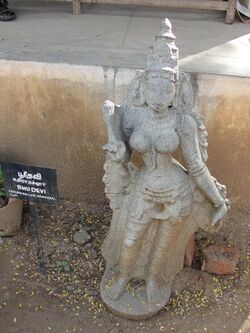Religion:Bhūmi
| Bhūmi | |
|---|---|
The goddess of Earth | |
| Member of The Pancha Bhoota | |
 Sculpture of Bhūmi | |
| Other names | Prithvi |
| Affiliation | Devi Avatar of Shri Lakshmi Pancha Bhoota |
| Abode | Vishnuloka/Vaikuntha, Dyuloka |
| Planet | Earth |
| Mantra | Om Bhumyai namah |
| Mount | Cow, Elephant |
| Personal information | |
| Consort | Varaha |
| Children | Narakasura, Mangala and Sita (according to some versions of Ramayana) |
| Equivalents | |
| Greek equivalent | Gaia |
| Roman equivalent | Tellus Mater |
| Manipuri equivalent | Leimarel Sidabi |
Bhūmi, Bhudevi, Bhūmī-Devī is the Hindu goddess representing Mother Earth. She is known by various names such as Bhuma-Devi, Bhuvati, Bhuvaani, Bhuvaneshwari, Avni, Prithvi, Varahi, Dharti, Dhaatri, Dharani, Vasudha, Vasundhara, Vaishnavi, Kashyapi, Urvi, Ira, Mahi, Ela, Vasumati, Dhanshika, Hema and Hiranmaya. She is depicted as seated on a platform which rests on the back of four elephants, representing the four directions of the world. She is usually depicted with four arms, respectively holding a pomegranate, a water vessel, a bowl containing healing herbs, and another bowl containing vegetables.[1] She is also sometimes depicted with two hands, the right hand holding a blue lotus known as Kumuda or Utpala, the night lotus, while the left hand may be in the Abhayamudra, the fearlessness or the Lolahasta Mudra, which is an aesthetic pose meant to mimic the tail of a horse.[2][3]
She is the consort of the boar god Varaha, an avatar of Vishnu.[4]
References
- ↑ T.A.G. Rao (1997). Elements of Hindu Iconography. Motilal Banarsidass. ISBN 81-208-0876-2.
- ↑ Margaret Stutley (2003). The Illustrated Dictionary of Hindu Iconography. Munshiram Manoharlal Publishers. p. 82. ISBN 81-215-1087-2.
- ↑ A. G. Mitchell; Victoria and Albert Museum (1982). Hindu gods and goddesses. United Kingdom: Her Majesty's Stationery Office. p. 8. https://books.google.com/books?id=P57pAAAAMAAJ&pg=PA8.
- ↑ "Killing of Narakasura". http://www.diwalifestival.org/killing-of-narakasura.html.


